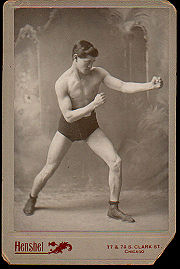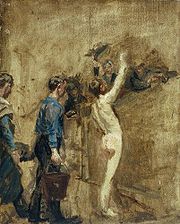
Salutat
Encyclopedia
Salutat is an 1898 painting by Thomas Eakins
(1844 – 1916). Based on a real-life boxing match that occurred in 1898, the work depicts a boxer waving to the crowd after the match. According to Eakins' biographer Lloyd Goodrich
, Salutat is "one of Eakins' finest achievements in figure-painting." The painting's title is Latin
for "He greets" or "He salutes."
 Much as he had with his paintings of rowers in the 1870s, during the late 1890s Eakins turned his interest again to the male nude, this time depicting prizefighters. Eakins attended fights in 1898, and aided by sportswriters Clarence Cranmer and Henry Walter Schlichter, met with and hired fighters to pose for him. The studio became a place to spar; according to Eakins's protege the sculptor Samuel Murray
Much as he had with his paintings of rowers in the 1870s, during the late 1890s Eakins turned his interest again to the male nude, this time depicting prizefighters. Eakins attended fights in 1898, and aided by sportswriters Clarence Cranmer and Henry Walter Schlichter, met with and hired fighters to pose for him. The studio became a place to spar; according to Eakins's protege the sculptor Samuel Murray
, (who in 1899 made a bronze statue of Billy Smith) one of the fighters, Ellwood McCloskey, would "round up fellow pugilists who had promised to pose but didn't show up":
"Turkey Point" Billy Smith, a featherweight who competed in over 100 bouts over the course of ten years and fought two featherweight champions, was the protagonist for Salutat as well as for Between Rounds.
 Eakins made multiple studies of the subject. A pencil-on-paper study was purchased by Joseph Hirshhorn
Eakins made multiple studies of the subject. A pencil-on-paper study was purchased by Joseph Hirshhorn
in 1965 and donated to his eponymous museum
in 1966.
Eakins also completed an oil-on-canvas study, which he gave to art critic Sadakichi Hartmann
after Hartmann praised Eakins in his 1901 book A History of American Art. (This was the first time Eakins had been recognized as being of historic importance.) This study is now in the possession of the Carnegie Museum of Art
.
Tim Callahan fought featherweight Billy Smith in a match that was close until the final round, when Callahan gained the advantage and won the fight. However, for Salutat, Eakins chose to depict Smith as the winner. In the work, Smith raises his hand to salute the audience, in the style of a Gladiator
. On the painting's original frame Eakins carved the words "DEXTRA VICTRICE CONCLAMANTES SALVTAT" (With the victorious right hand, he salutes those shouting [their approval]).
As with a number of other Eakins works, the rendering of the figures is extremely precise, such that it has allowed art historians to identify individual members of the audience. While working on the boxing pictures, friends would visit the studio, and Eakins invited them to "stay a while and I'll put you in the picture." For Salutat, audience members include Eakins's friend Louis Kenton (wearing eyeglasses and a bow tie), sportswriter Clarence Cranmer (wearing a bowler hat), David Jordan (brother of Letitia Wilson Jordan, whom Eakins painted in Portrait of Letitia Wilson Jordan), photographer Louis Husson (next to Jordan), Eakins's student Samuel Murray
, and Eakins's father Benjamin Eakins.
Smith is bathed in soft white light, which illuminates his muscles. Amid a general tonality of warm grays and browns that contains no strong chromatic notes, the skin tones of the three main figures are pale. All three men have the quality of relief sculpture, and with Smith's figure separate from those of his seconds, they appear to move across the canvas in an arrangement reminiscent of a frieze
.
The painting remained unsold during Eakins's lifetime, and was bought from his widow by Thomas Cochran in 1929; he subsequently donated the picture to the Addison Gallery of American Art
at Phillips Academy
in Andover, Massachusetts
.
Thomas Eakins
Thomas Cowperthwait Eakins was an American realist painter, photographer, sculptor, and fine arts educator...
(1844 – 1916). Based on a real-life boxing match that occurred in 1898, the work depicts a boxer waving to the crowd after the match. According to Eakins' biographer Lloyd Goodrich
Lloyd Goodrich
Lloyd Goodrich was an influential American art historian. He wrote extensively on American artists, including Edward Hopper, Thomas Eakins, Winslow Homer, Raphael Soyer and Reginald Marsh...
, Salutat is "one of Eakins' finest achievements in figure-painting." The painting's title is Latin
Latin
Latin is an Italic language originally spoken in Latium and Ancient Rome. It, along with most European languages, is a descendant of the ancient Proto-Indo-European language. Although it is considered a dead language, a number of scholars and members of the Christian clergy speak it fluently, and...
for "He greets" or "He salutes."
Background

Samuel Murray
Samuel Aloysius Murray was an American sculptor, and protégé of the painter Thomas Eakins.-Murray and Eakins:...
, (who in 1899 made a bronze statue of Billy Smith) one of the fighters, Ellwood McCloskey, would "round up fellow pugilists who had promised to pose but didn't show up":
"Hey, you son of a bitch, haven't you got a date to pose for Mr. Eakins? Come on now, or I'll punch your goddamn head off."
"Turkey Point" Billy Smith, a featherweight who competed in over 100 bouts over the course of ten years and fought two featherweight champions, was the protagonist for Salutat as well as for Between Rounds.
Studies

Joseph Hirshhorn
]Joseph Herman Hirshhorn was an entrepreneur, financier and art collector. Born in Mitau, Latvia, the twelfth of thirteen children, Hirshhorn emigrated to the United States with his widowed mother at the age of six....
in 1965 and donated to his eponymous museum
Hirshhorn Museum and Sculpture Garden
The Hirshhorn Museum and Sculpture Garden is an art museum beside the National Mall, in Washington, D.C., the United States. The museum was initially endowed during the 1960s with the permanent art collection of Joseph H. Hirshhorn. It was designed by architect Gordon Bunshaft and is part of the...
in 1966.
Eakins also completed an oil-on-canvas study, which he gave to art critic Sadakichi Hartmann
Sadakichi Hartmann
Carl Sadakichi Hartmann was a critic and poet of German and Japanese descent.Hartmann, born on the artificial island of Dejima, Nagasaki and raised in Germany, became an American citizen in 1894. An important early participant in modernism, Hartmann was a friend of such diverse figures as Walt...
after Hartmann praised Eakins in his 1901 book A History of American Art. (This was the first time Eakins had been recognized as being of historic importance.) This study is now in the possession of the Carnegie Museum of Art
Carnegie Museum of Art
The Carnegie Museum of Art, located in the Oakland neighborhood of Pittsburgh, Pennsylvania, is an art museum founded in 1895 by the Pittsburgh-based industrialist Andrew Carnegie...
.
Composition
Salutat, Between Rounds (a portion of which was executed separately as Billy Smith) and Taking the Count are a series of three large boxing paintings done by Eakins. The former two depict events surrounding a boxing match that took place on April 22, 1898. FeatherweightFeatherweight
Featherweight is a weight class division in the sport of boxing. There are similarly named divisions under several Mixed Martial Arts organizations and in Greco-Roman wrestling.-Professional boxing:...
Tim Callahan fought featherweight Billy Smith in a match that was close until the final round, when Callahan gained the advantage and won the fight. However, for Salutat, Eakins chose to depict Smith as the winner. In the work, Smith raises his hand to salute the audience, in the style of a Gladiator
Gladiator
A gladiator was an armed combatant who entertained audiences in the Roman Republic and Roman Empire in violent confrontations with other gladiators, wild animals, and condemned criminals. Some gladiators were volunteers who risked their legal and social standing and their lives by appearing in the...
. On the painting's original frame Eakins carved the words "DEXTRA VICTRICE CONCLAMANTES SALVTAT" (With the victorious right hand, he salutes those shouting [their approval]).
As with a number of other Eakins works, the rendering of the figures is extremely precise, such that it has allowed art historians to identify individual members of the audience. While working on the boxing pictures, friends would visit the studio, and Eakins invited them to "stay a while and I'll put you in the picture." For Salutat, audience members include Eakins's friend Louis Kenton (wearing eyeglasses and a bow tie), sportswriter Clarence Cranmer (wearing a bowler hat), David Jordan (brother of Letitia Wilson Jordan, whom Eakins painted in Portrait of Letitia Wilson Jordan), photographer Louis Husson (next to Jordan), Eakins's student Samuel Murray
Samuel Murray
Samuel Aloysius Murray was an American sculptor, and protégé of the painter Thomas Eakins.-Murray and Eakins:...
, and Eakins's father Benjamin Eakins.
Smith is bathed in soft white light, which illuminates his muscles. Amid a general tonality of warm grays and browns that contains no strong chromatic notes, the skin tones of the three main figures are pale. All three men have the quality of relief sculpture, and with Smith's figure separate from those of his seconds, they appear to move across the canvas in an arrangement reminiscent of a frieze
Frieze
thumb|267px|Frieze of the [[Tower of the Winds]], AthensIn architecture the frieze is the wide central section part of an entablature and may be plain in the Ionic or Doric order, or decorated with bas-reliefs. Even when neither columns nor pilasters are expressed, on an astylar wall it lies upon...
.
Exhibition and provenance
Eakins sent the painting to the Annual of the Pennsylvania Academy in January 1899, and although it "failed to please the few critics who noticed it", he exhibited the picture a total of four times in the next five years.The painting remained unsold during Eakins's lifetime, and was bought from his widow by Thomas Cochran in 1929; he subsequently donated the picture to the Addison Gallery of American Art
Addison Gallery of American Art
The Addison Gallery of American Art, as a department of Phillips Academy, Andover, Massachusetts, is an academic museum dedicated to collecting American art...
at Phillips Academy
Phillips Academy
Phillips Academy is a selective, co-educational independent boarding high school for boarding and day students in grades 9–12, along with a post-graduate year...
in Andover, Massachusetts
Andover, Massachusetts
Andover is a town in Essex County, Massachusetts, United States. It was incorporated in 1646 and as of the 2010 census, the population was 33,201...
.
Sources
- Henry Adams. Eakins Revealed: the Secret Life of an American Artist. Oxford University Press US, 2005. ISBN 0195156684.
- Martin A. Berger. Man Made: Thomas Eakins and the Construction of Gilded Age Manhood. Berkeley: University of California Press, 2000.
- Lloyd Goodrich. Thomas Eakins. Harvard University Press, 1982. ISBN 0-674-88490-6
- Sidney Kirkpatrick. The Revenge of Thomas Eakins. Yale University Press, 2006. ISBN 0300108559
- Christian K. Messenger. Sport and the Spirit of Play in American fiction: Hawthorne to Faulkner. Columbia University Press, 1981. ISBN 0231051689
- Sewell, Darrel; et al. Thomas Eakins. Yale University Press, 2001. ISBN 0-87633-143-6

